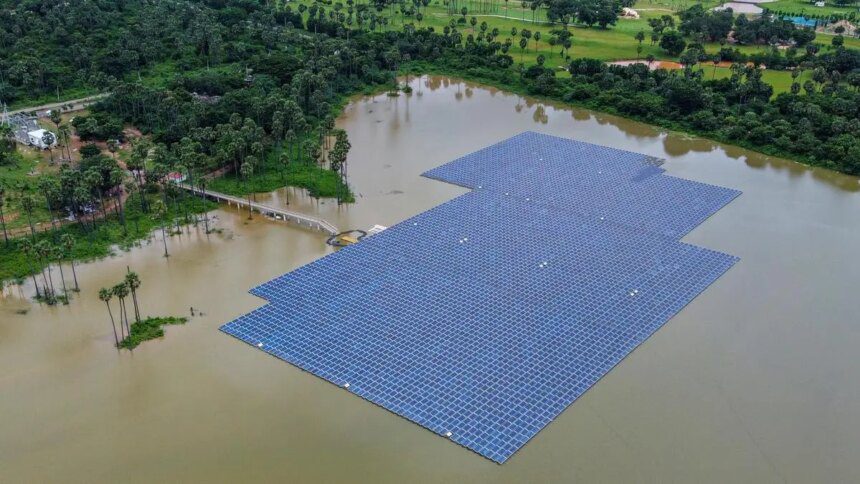Floating solar photovoltaic (FPV) technology presents a promising alternative to traditional terrestrial solar energy parks, particularly in urban areas where land is limited and costly. India aims to achieve 500 gigawatts (GW) of non-fossil fuel energy capacity by 2030, which includes a substantial goal of installing about 280 GW of solar energy. Recently, the nation surpassed the 250-GW milestone in non-fossil fuel energy capacity.
A study published in the journal Energy for Sustainable Development by authors Pradhuman Shaktawat, Abhinav Jindal, and S Abhilash Kumar indicates that utilizing just 10 percent of India’s water resources could yield approximately 227 GW of FPV power.
In addition to conserving land, FPV systems offer benefits such as increased efficiency and energy output, which can be 5 to 10 percent higher than ground-mounted solar systems due to the cooling effect of water. Moreover, covering the surface of water bodies with FPVs can significantly reduce evaporation, which is advantageous for dams used in irrigation and hydropower generation.
However, the widespread adoption of FPVs faces challenges, including higher initial costs compared to conventional ground-based solar implementations.
Identifying Optimal Locations
The authors conducted an analysis of 130 hydropower reservoirs in India that met their criteria for FPV deployment. They identified 17 reservoirs that are technically suitable, particularly in terms of minimizing challenges related to anchoring, mooring, and power evacuation. Among the states, Maharashtra has the largest number of suitable reservoirs, followed by Odisha. The Almatti reservoir in Karnataka was deemed the most suitable, featuring high global horizontal irradiance (the amount of solar radiation received by the water surface) and moderate fluctuations in water levels.
To assess the financial viability of FPVs, the authors examined the levelized cost of energy (LCOE)—the average cost to generate one kilowatt-hour (kWh) of electricity across a project’s lifespan. For selected reservoirs, the LCOE for FPVs ranged from ₹3.16 to ₹3.80 per kWh, notably lower than the national average electricity tariff of ₹6.29 per kWh. The Tungabhadra reservoir achieved an LCOE of ₹3.16 per kWh, attributed to its exceptional energy yield.
Despite being more competitive in general, FPV systems entail higher installation costs than land-based solar panels. For instance, the LCOE for the Almatti reservoir is approximately 12.5 percent greater than that for traditional solar installations, primarily due to the 15.5 percent higher capital expenditure associated with necessary components, such as floating structures and anchoring systems.
The authors suggest targeted policy interventions to bridge this cost gap and promote large-scale adaptation. They recommend an interest rate subsidy of 1.75 percent or a 12 percent capital expenditure subsidy to equalize the costs between FPVs and land-based solar systems. Alternatively, the government could implement an incentive based on 12.5 percent of the FPV LCOE relative to the power produced.
Sustainability Concerns
Beyond financial aspects, FPVs also encounter non-financial challenges, including the absence of standardized components, insufficient local manufacturing capabilities, and the requirement for approvals from multiple governmental entities.
The long-term environmental sustainability of FPVs remains uncertain. While they are estimated to provide net annual CO2 savings of 970 to 1,167 tons per megawatt (MW) of capacity, their deployment might impact local biodiversity and aquatic ecosystems adversely.
To mitigate risks to livelihoods, such as fishing and tourism affected by FPV projects, the authors advocate for a structured social impact assessment that incorporates stakeholder consultations. Dr. Shaktawat emphasizes that compensation or benefit-sharing mechanisms, akin to those employed in hydropower resettlement strategies, might be beneficial in facilitating the adoption of FPVs.
He also highlighted that inadequate data on water depths in reservoirs could have a significant influence on the study’s final rankings. This data would be crucial for refining LCOE estimates by factoring in precise anchoring costs.
Published on November 24, 2025










